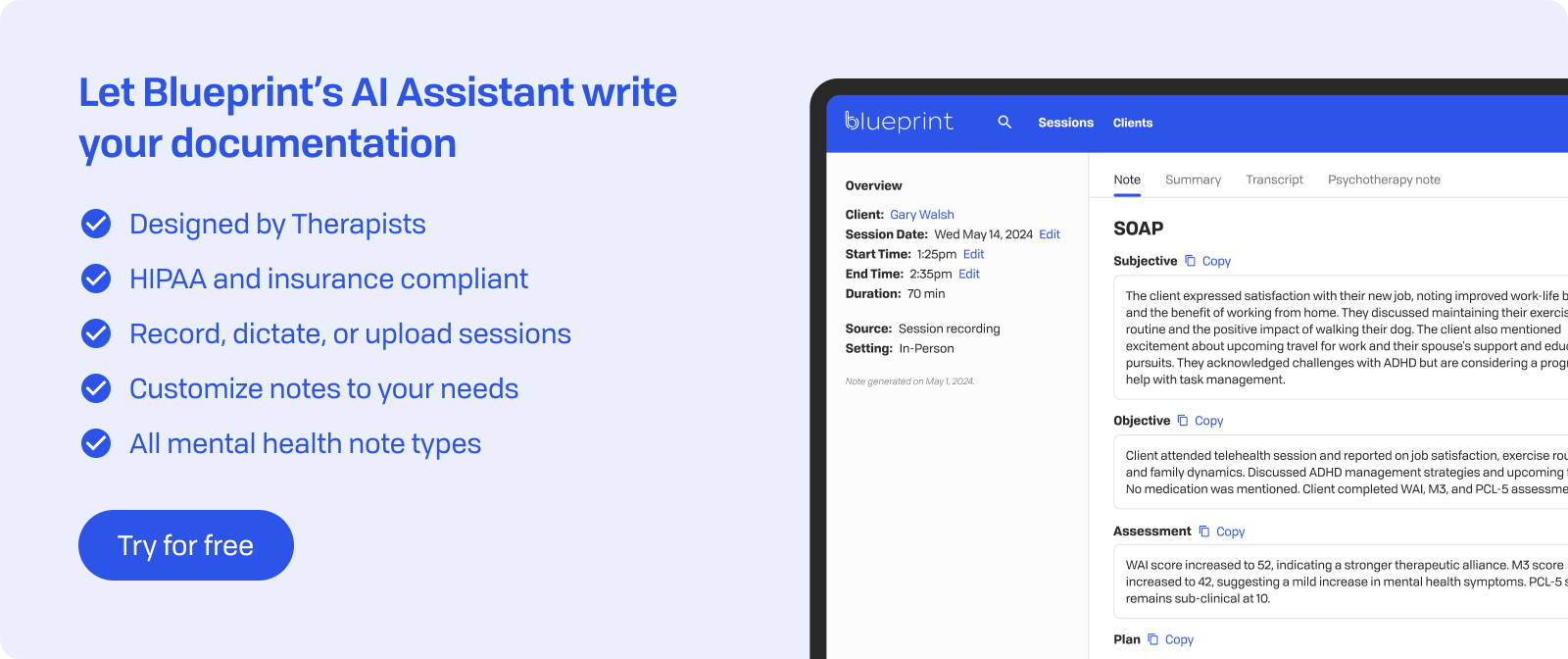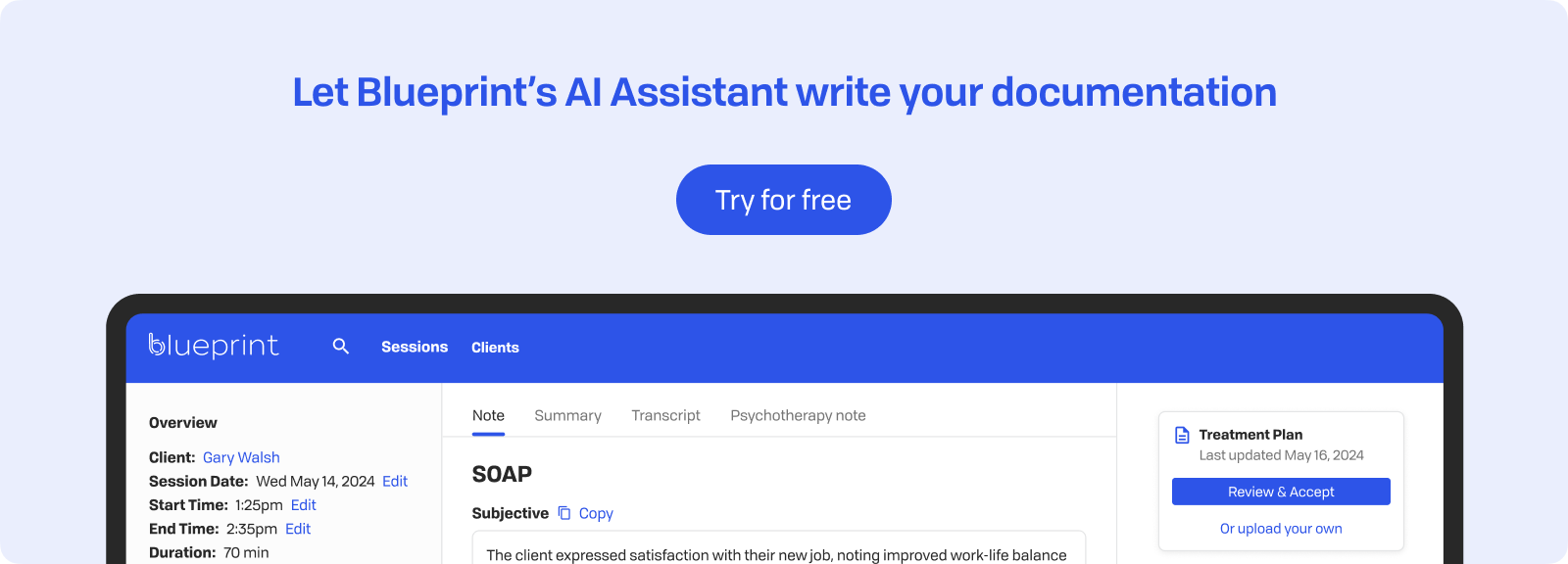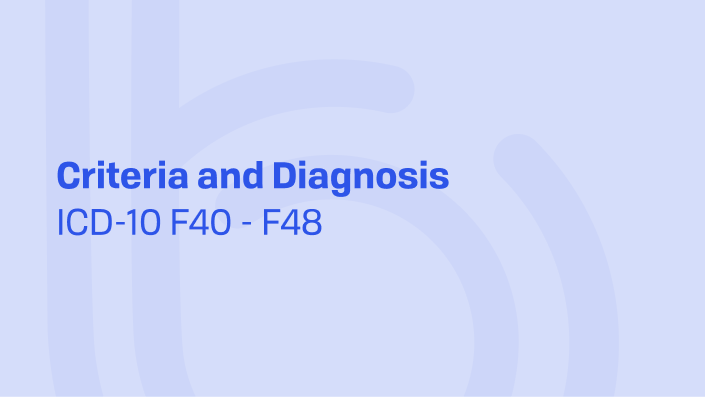In Brief
Finding your way through diagnostic codes can feel overwhelming, especially while juggling accurate documentation, providing quality care, and jumping between diagnosing using DSM-5-TR criteria and the ICD-10 coding structure. The ICD-10 classification system plays a big role in daily practice, affecting everything from treatment planning to insurance reimbursement.
Grasping anxiety-related codes within the F40-F48 range is particularly important given how common these conditions are in clinical settings. These codes cover neurotic, stress-related, and somatoform disorders, including many of the anxiety conditions commonly seen in clinical settings. These codes provide a standardized framework for documenting diagnoses accurately and supporting appropriate treatment and reimbursement.
Getting familiar with these codes isn't just about administrative tasks—it's about making sure clients get the right care and coverage. Let's look at the most commonly used anxiety codes and how they apply in real clinical situations.
Most Common Anxiety ICD-10 Codes
The F40-F48 category includes a wide range of anxiety and stress-related conditions. While not exhaustive, the following are among the codes most often used in clinical practice:
- F40.00 – Agoraphobia, unspecified: Used when a client experiences intense fear or avoidance of situations where escape might be difficult, but details are limited.
- F40.10 – Social phobia, unspecified: Applied when a client has marked anxiety in social situations, often leading to avoidance, but without further specification.
- F40.9 – Phobic anxiety disorder, unspecified: A general code for significant phobic anxiety when a more specific phobia is not identified.
- F41.0 – Panic disorder without agoraphobia: Used for recurrent, unexpected panic attacks not accompanied by agoraphobia.
- F41.1 – Generalized anxiety disorder (GAD): Applied when a client experiences excessive, persistent worry across multiple areas of life, often accompanied by physical symptoms (e.g., restlessness, muscle tension).
- F41.9 – Anxiety disorder, unspecified: A common code when symptoms clearly indicate anxiety but do not fully meet criteria for a more specific anxiety disorder.
- F42 – Obsessive‑compulsive disorder (OCD): Used when clients present with persistent obsessions, compulsions, or both, significantly impacting daily life.
- F43.22 – Adjustment disorder with anxiety: Used when a client shows significant anxiety in response to a recent identifiable stressor.

Diagnostic Criteria & Documentation Standards
For U.S. clinicians, ICD-10 coding relies on DSM-5-TR criteria to establish accurate diagnoses. Each anxiety disorder has specific requirements that must be met and documented clearly in clinical notes to ensure both clinical accuracy and compliance.
Generalized Anxiety Disorder (F41.1) requires documenting:
- At least six months of persistent, excessive worry about multiple areas
- Three or more symptoms such as restlessness, fatigue, concentration difficulties, irritability, muscle tension, or sleep disturbance
- Clear functional impairment in social, occupational, or other important areas
Panic Disorder (F41.0) documentation must include:
- Recurrent, unexpected abrupt surges of intense fear or discomfort that occur with four or more of the following symptoms: racing heart, sweating, trembling, shortness of breath, feeling of choking, chest pain, nausea, dizziness, derealization, fear of losing control, fear of dying, numbness, or chills or heat sensations
- Persistent concern about additional attacks lasting at least one month
- Significant behavioral changes related to the attacks
Phobic Disorders (F40.x) require noting:
- Marked, persistent fear about a specific object or situation that's excessive or unreasonable
- Immediate anxiety response upon exposure to the feared object or situation
- Recognition that the fear is disproportionate to the actual danger (except in children)
- Avoidance behaviors or endurance with intense distress
Key documentation practices for recording services treating anxiety disorders include:
- Timeline specificity: Record exact onset dates and symptom duration
- Severity indicators: Note the intensity and frequency of symptoms. Use standardized assessments to quantify symptoms when possible.
- Functional impact: Detail how symptoms affect work, relationships, and daily activities
- Rule-out documentation: Explain how you excluded medical conditions, substance-induced anxiety, or other psychiatric disorders
- Observable behaviors: Focus on objective symptoms rather than subjective impressions
Common Pitfalls in Coding & How to Avoid Them
Even experienced therapists can make coding mistakes that affect treatment planning and reimbursement. Here are the most frequent errors and how to avoid them:
Overusing F41.1 as a default code is perhaps the most common mistake. Many clinicians assign Generalized Anxiety Disorder without confirming the six-month duration requirement or documenting the necessary physical symptoms. Remember that GAD requires persistent worry plus specific autonomic symptoms—not just general anxiety.
Mislabeling mild discomfort as a phobic disorder can occur when we confuse normal apprehension with clinical-level impairment. True phobias (F40.x) require marked fear that significantly disrupts functioning. A client who dislikes public speaking but manages work presentations doesn't meet criteria for social phobia.
F41.9 (Anxiety disorder, unspecified) should be reserved for:
- Initial assessments when you need more information
- Cases where symptoms don't clearly fit established categories
- Situations where full criteria aren't met but clinical anxiety is present
Distinguishing adjustment disorders with anxiety (F43.22) from full anxiety disorders requires careful attention to triggers and timelines. Adjustment disorders:
- Have identifiable stressors within three months of symptom onset
- Typically resolve within six months after the stressor ends
- Don't meet full criteria for other anxiety disorders
The key difference lies in proportionality—adjustment disorders represent excessive but time-limited responses to specific life changes, while anxiety disorders persist independently of external circumstances.

Clinical Presentation & Comorbid Conditions
Anxiety disorders are among the most common mental health conditions in the United States, affecting about about 19.1% of U.S. adults each year, with higher rates in females (23.4%) compared to males. The impact extends across all areas of life—academic performance, career advancement, and relationship quality often suffer significantly.
For U.S. clinicians, accurate ICD-10 coding depends on aligning the client’s presentation with DSM-5-TR criteria while also capturing the broader clinical picture. Anxiety may present as excessive worry, restlessness, irritability, muscle tension, or sleep disturbance, but it can also manifest through avoidance behaviors, physical complaints, or difficulty concentrating.
Common comorbidities add complexity to both diagnosis and treatment:
- Depressive disorders: These conditions often share overlapping symptoms with anxiety such as sleep disturbance, irritability, and concentration difficulties.
- Substance use disorders: Many clients attempt to self-medicate anxiety symptoms, creating a cycle that worsens both conditions.
- Trauma-related disorders: PTSD and anxiety disorders frequently co-occur, making careful assessment of trauma history essential.
In addition, medical conditions and substance effects can mimic or exacerbate anxiety. Thyroid disorders, cardiac issues, and respiratory conditions may present with anxiety-like symptoms. Likewise, caffeine intoxication, stimulant use, or withdrawal from substances can trigger similar physiological and psychological responses.
Clinicians should carefully document their differential diagnosis process, noting any medical evaluations or substance use assessments that help rule out alternative explanations. This comprehensive approach supports accurate ICD-10 coding, strengthens clinical documentation, and ensures clients receive the most appropriate treatment without unnecessary delays.

Using ICD-10 Codes to Inform Treatment Planning
An accurate diagnosis with the right ICD-10 code directly influences the treatment approach and helps identify which interventions will most likely work best. Each anxiety code has specific evidence-based treatments that have shown success for that particular condition.
Matching diagnoses to interventions:
- F40.2 (Specific Phobias): Exposure and response prevention (ERP)
- F41.1 (Generalized Anxiety Disorder): Cognitive behavioral therapy (CBT), acceptance and committment therapy (ACT, and interpersonal psychotherapy (IPT)
- F41.0 (Panic Disorder): Cognitive behavioral therapy (CBT) and breathing retraining
- F40.1 (Social Phobia): Exposure and response prevention (ERP)
Accurate coding helps streamline insurance approval processes and reduce claim denials. When the documented diagnosis aligns with the treatment interventions, insurers can easily verify medical necessity. For instance, submitting exposure therapy sessions for F40.2 makes clinical sense, while the same treatment for F41.1 might raise questions.
Structuring phased treatment becomes clearer with specific codes:
- Initial phase: Symptom stabilization based on code-specific presentations
- Middle phase: Core interventions targeting the primary diagnosis
- Maintenance phase: Relapse prevention tailored to the disorder
Use ICD-10 codes and diagnoses to determine appropriate, measurable treatment goals. A client with F41.0 might track panic attack frequency, while someone with F41.1 would consider monitoring worry duration and intensity. This code-driven approach provides a logical framework for progress notes, treatment reviews, and outcome measurement, ensuring every aspect of care connects back to the initial diagnosis.
Evidence-Based Interventions & Clinical Tools
Adjusting interventions to specific ICD-10 anxiety codes helps ensure focused and effective treatment. Here's how evidence-based approaches fit with each diagnosis:
CBT Strategies for Specific Anxiety Subtypes:
- F40.1 (Social Anxiety): Cognitive restructuring aimed at addressing fear of negative evaluation from CBT,
- F41.1 (GAD): Cognitive defusion techniques from ACT
- F41.0 (Panic Disorder): Education on the panic cycle, and cognitive restructuring of catastrophic interpretations in ERP
Structured Exposure Protocols:
- Phobias (F40.2): Develop fear hierarchies with 8-12 items, starting with the least threatening exposures
- Panic Disorder: Teach breathing exercises for 2-3 minutes each
- GAD Worry Exposure: Set aside 30-minute "worry periods" using imaginal exposure to worst-case scenarios
Key Assessment Tools:
- GAD-7: Quick screening and progress monitoring for all anxiety disorders
- BAI (Beck Anxiety Inventory): Detailed symptom assessment, particularly useful for panic disorder
- SPIN (Social Phobia Inventory): Specific to social anxiety severity
- Y-BOCS: When anxiety includes obsessive features
Crisis Management for Severe Anxiety:
- Create written safety plans that identify triggers, coping strategies, and emergency contacts
- Set up clear plans for client to follow when experiencing panic attacks. These plans may include grounding techniques, breathing exercises, reality testing statements
- Coordinate with the client’s care team, including psychiatrists for cases with severe impairment
- Document crisis interventions thoroughly

Key Takeaways
Getting ICD-10 anxiety coding right significantly impacts your practice. Accurate coding affects treatment quality, ensures proper reimbursement, and creates clear clinical documentation that follows your clients throughout their care journey.
Keep these important points in mind:
- Each anxiety code has specific requirements: F41.1 needs six months of worry plus physical symptoms, F41.0 requires recurrent panic attacks with ongoing concern, and F40.x codes demand marked fear with functional impairment.
- Avoid the F41.1 trap: Don't default to GAD when full criteria aren't met—use F41.9 for unclear presentations or F43.22 for adjustment-related anxiety.
- Let diagnosis influence treatment decisions: Specific phobias respond best to exposure therapy, GAD benefits from other evidence based practices, such as ACT and CBT.
- Document with precision: Include symptom duration and intensity, severity measures, functional impact, and rule-out considerations in every assessment.
- Use standardized tools: The GAD-7, BAI, and SPIN provide objective data that support your diagnostic decisions and track progress.
Accurate coding isn't just about administrative compliance—it ensures clients receive targeted interventions that match their specific anxiety presentation. When you take time to distinguish between anxiety subtypes and document thoroughly, you're setting up a treatment framework that insurance companies understand and clients benefit from. This precision in coding translates directly into better clinical outcomes and smoother practice operations.

How Blueprint can help streamline your workflow
Blueprint is a HIPAA-compliant AI Assistant built with therapists, for the way therapists work. Trusted by over 50,000 clinicians, Blueprint automates progress notes, drafts smart treatment plans, and surfaces actionable insights before, during, and after every client session. That means saving about 5-10 hours each week — so you have more time to focus on what matters most to you.
Try your first five sessions of Blueprint for free. No credit card required, with a 60-day money-back guarantee.
























